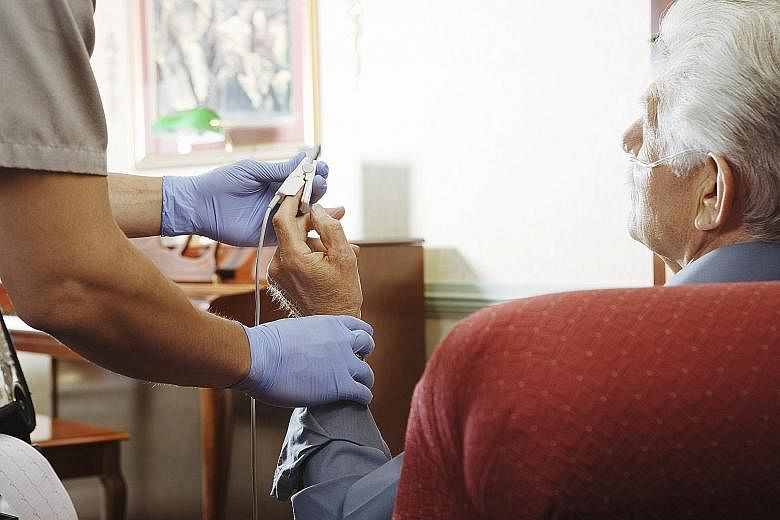A few weeks ago, in the hospital in the United States where I work, I was telling a 92-year-old patient about her discharge plan. I wanted her to follow up in my office in a week. Frail and soft-spoken, she asked me if instead I could visit her at home. "I'm afraid not," I said automatically, but when she asked me why, I didn't have a good answer.
Before World War II, about 40 per cent of all doctor-patient encounters were house calls. Today, the proportion has dwindled to less than 1 per cent. The major reason, not surprisingly, is money: Travelling to patients' homes is inefficient and almost never profitable for doctors or hospitals. But I believe that if we revived the house call, the overall savings to the healthcare system, not to mention the impact on patient care, would be enormous.
I have made an occasional house call, and what I've learnt about my patients has been invaluable.
One patient of mine had severe heart failure that rendered him too weak to come see me, unless he was brought to the emergency room by ambulance. He lived only a mile from the hospital, so I went to visit him. In his kitchen sink was a mess of dirty dishes. I looked in the fridge; it was nearly empty. There were canned soups on the counter, all loaded with sodium, precisely what he should not have been consuming.
His wife was sitting silently at the dining table, appearing exhausted. It was then that I learnt she had stopped driving. It didn't matter which medications I ordered at the pharmacy; he had no way to get them.
My patient had been hospitalised four times in six months - in part because we didn't know what was going on at his home.
Rehospitalisation is a huge and costly problem in the United States, where the rate has increased 50 per cent over the past three decades. Today, about one in five Medicare patients discharged from the hospital is rehospitalised within a month. A third of those patients are rehospitalised within a week. Removing elderly patients from their homes and sending them back to the alien environment of the hospital is often traumatising.
Neither doctors nor hospitals have tried very hard to tackle this problem. We don't ensure that patients released from the hospital obtain their medications and know how to take them. We don't secure timely medical follow-ups. Most of the time we don't communicate with patients' primary care physicians. And, of course, we almost never visit them at home.
This goodbye-and-good-luck attitude costs us a lot of money. The price tag of unplanned readmissions is US$17 billion (S$23 billion) a year for Medicare alone. Given the huge costs, it is no surprise that the Obama administration has been penalising hospitals with higher-than-average readmission rates. Last year, about 2,600 hospitals across the country were docked up to 3 per cent of their total Medicare revenue, for a total of US$420 million.
You would think such penalties would have a big impact on the discharge planning at most hospitals, which operate with very narrow profit margins. They don't.

From the standpoint of the bottom line, it makes more sense for hospitals to keep their beds filled, even with readmitted patients. Daily hospital bed outlays dwarf readmission penalties. Our current payment system rewards hospitals much more for letting patients in than for keeping them out.
A majority of readmission costs could be saved with better care coordination, including home visits. At a recent conference in California, I heard about all sorts of good Samaritan work focused on providing care at home, such as churches partnering hospitals to reduce hospitalisations in "vulnerable populations", especially the elderly.
One firm, MedStar, a Texas-based ambulance service, consults hospitals to determine if patients calling 911 really need to be taken to the emergency room. In 2008, 21 residents of the greater Fort Worth area went to the ER more than 2,000 times, costing nearly US$1 million in ambulance charges alone. MedStar identified the "frequent fliers" and developed care plans for them, including regularly scheduled home visits. The result, the service reports, was an 80 per cent reduction in readmissions in this high-risk group.
The readmission problem will not be easy to solve. Some patients decline home visits. Some have dementia, a known predictor of readmission. Some things, like progressive debility, you can't prevent. And we can't make follow-up appointments for our patients if there aren't enough primary care physicians available to see them.
But poor communication and coordination, big drivers of readmissions, can be remedied. Anaemic penalties are a start, but they won't get the job done. There is substantial variation in readmission rates across the United States, suggesting that improvement on a national scale is possible.
The key to improving the hospital-to-home transition is a better understanding of the home component. For doctors, patients' homes shouldn't be a black box.
NEW YORK TIMES
•The writer is a cardiologist and an author.

